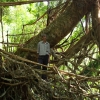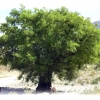Interview with Mr. Raj Gupta.
Mr. Gupta is the District Program Officer (DPO), Livelihoods of Uttar Bastar Kanker, Zila Parishad. As a Development Practitioner he has extensive experience of working with the adivasi communities of Uttar-Bastar Kanker district of Chhattisgarh and have lead several livelihoods projects. One can consider him to be an expert on prospecting livelihood opportunities for the adivasi communities owing to his deep understanding of the adivasi ethos and culture.
Introduction:
A large part of the landscape of Bastar is forests which are inhabited by adivasis. We wish to have a conversation around how life in Bastar has a deep connection with the elements that constitutes the forest and whatever comes out of it during every season (summer, monsoon, winter and spring). One can say that every season brings out of the forest a wide array of products which shape the livelihood of these adivasi communities. Such as Mahua in Spring, followed by Tendu during the Summer, Bamboo shoots during early monsoon and Pemdana/ Pembeeja during the autumn season. So the life of the forest dwellers are basically arranged according to whatever comes out of the forest, especially in the context of Bastar.
Question 1: In the context of southern Chhattisgarh especially Bastar/ Uttar Bastar - Kanker how significant is the role of Forest Produces as a Livelihood option for the forest dwelling Adivasis and also Non Adivasi traders? What would be an approximate figure (statistical figure) of the impact of forest produces on the livelihoods of the adivasis?
Raj Gupta: The whole of Bastar is a forested belt and it is very well known that a lot of forest produces are coming from Bastar. It is not just that a few NTFPs are coming out of it but also a wide variety of food produces comes out of it. So it is not just livelihoods (as in products that they sell and encash) but also a lot of food that they consume. For example Mahua, which is edible, they eat it. Chironjee, which is highly nutritious, they consume it, oil from Tori (seed of Mahua fruit) they also consume it. One can say that about 50-60 percent of the income of the tribals (adivasis) comes from NTFPs. As you also said that every season they get something or the other from the forest. So across the year the significance of the forest produces are extremely high for both income and direct consumption, on the lives of the adivasis.
Question 2: Linked to this question is the issue that certain products that come out of the forest are economically more important than others. May be some of these products travel a long distance as their demands are in far away places like Kolkata, Bombay or even outside the country such as the United States of America (US). Parallely there are certain other kind of products which have a local demand; a demand that is generated from the community itself. Can you tell us a few stories or something which can explain these different kinds of products? Which products fall into which category? and how the market gets arranged for such a diverse array of products?
Raj Gupta: There are few products that Bastar is very rich in, one of them is Lac. Kanker district is the largest producer of Lac in the whole state. Most of the lac which we produce travel long distances to cities like Kolkata, Bombay and also outside India where they are used for Indistrial as well as cosmetic purposes. The wood industry also uses these products. Secondly the ayurvedic products; Harra and Behra are two things that are used in ayurvedic medicines. These things are going to Uttarakhand, Delhi and also across Southern India where ayurvedic industry is thriving, Bastar is the region which is supplying them with a major portion (20-30 percent) of all the products that are required in these industries. Similarly if you talk about the Saree industry, i.e. the silk saree industry, the production of cocoon in Bastar is very high. Also the quality of cocoon which is being produced in Bastar is much better than the quality of cocoons coming from other parts of the country. So cocoons from this part of Bastar is going to Kanjipuram, for Kanjipuram Sarees, Sonpur and other places which are weaving silk sarees so these are the 3-4 things that come out of Bastar which have a high value market outside Bastar. Other than these Tamarind is another product; You will find it astonishing that Bastar’s Headquarter, Jagdalpur is the biggest market of Tamarind in the whole of Asia, It is the biggest mandi in the whole of Asia and determines the price of tamarind all across India. According to demand and supply and production of Tamarind in Bastar the prices of tamarind gets determined. Apart from these, Amchur (dried mango), Chironjee and Sal seeds are also produced and are bought by various industries across India.
Question 3: As you mentioned these (for the above mentioned products such as Tamarind, Amchur, Lac) and Industrial line up generates the demand. The place of demand is geographically separated from the place of production; but there are certain products which comes out of the forest where the place of consumption and place of production of those products are not very far away as in they are not geographically separated but the products often get mediated or routed through the market or the local haats. What sort of products gets routed through these markets; especially from the perspective of a Development Practitioner how can these patterns looked into? Given the consumption patterns are related to the cultural practices of the adivasis which generate a demand.
Raj Gupta: Tribals have a very rich culture and some of the practices are embedded in their culture. They have a culture of drinking Mahua. Mahua is one product which has a local demand and is routed through the market. What happens is that during spring season a lot of mahua is produced and collected by the people. They sell it at almost negligible price approximately 20-30 Rs per Kilogram to the local traders and middlemen. The local traders then save them in cold storages and within 3-4 months time i.e from August September onwards when the celebration season starts the same group of adivasis will buy the mahua to make liquor at double the price from the traders i.e 50-60 rupees per Kilogram. The traders make a flying profit by just storing mahua in their godowns and cold storages for 3-4 months. An adivasi family can end up losing a major part of their earnings from NTFP just buying mahua back from the traders during the celebration season after September. Soaps made of mahua seeds (tori)are also important as tori is sold at extremely low cost. The oil from tori used both for consumption and also sold to traders who in turn sell it to soap manufacturers who make cheap soaps of mahua which are resold back to the community through the local haats. These products are those which are resold back to the community after a brief mediation of the markets and manufacturers.
Question 4: A large part of 'Life' in Bastar revolves around leaves. There is bamboo leaves, sal leaves, tendu leaves which have a lot of economic value. There are some other leaves such as sihari leaves which have a ritualistic value as well as use value in form of plates or patri or even dona/ leaf cups. Sal leaves have both commercial and ritual value. With tendu the leaves of tendu have become so important that the tendu fruit which used to be considered as a good famine food is not grown any more and is disappearing. How do you think that the growing economy around leaves are changing the way of life.
Raj Gupta: If you go to a tribal household you will find that sal leaves are being used as plates and cups. They are used during marriages or any social event. Sal leaves are also used for cooking, more as a wrap (no eating). Other than sal, sihari is also used for making plates and cups. But these days silver coated paper plates are substituting leaf plates and cups. Also the forest department prevents people from plucking tree leaves which are slowing down the usage of leaf plates and cups. On the other hand Tendu leaf from Bastar are known to be of very high quality. They are green and make excellent wraps for beedis. Tendu leaves from bastar have greater qualitative value than tendu leaves from other part of our country. They also fetch better price. The collection is completely controlled by the forest department. The money for collection however goes to the people. But the forest department policy of plucking young tendu leaves from shrubs do not allow tendu plants to grow into trees. With this we see a disappearance of tendu fruit which used to be abundant 15-20 years ago. Tendu fruit when dried out could be stored for long periods and worked as food during the times of food scarcity. It used to work as food security for the tribals alongside dried mahua flowers. These are disappearing these days.
Question 4: One can observe that the market plays a large role in giving value to what comes out of the forest. Can we increasingly observe that a lot of what the market is demanding is also being grown in the forest? As in can we say that a lot of what now grows in the forest is under the dictates of what the market considers value able? For example: amongst timber...eucalyptus plantations for aforestation program is largely funded by the paper industry and they cover considerable land under forest cover. Do you think certain NTFP also gets grown within the forest which is slowly changing the forest as per the demands of the market?
Raj Gupta: Although I see Industry as something different from the forest and it is not leading to aforestation. However I also see it happening for example a lot of medicinal ayurvedic medicine are sourced out of the forest and some of the herbs are highly valuable and highly priced, if the demand is high of particular herb people tend to go for that sort of herbs. For example tikhu is a root which was used for food consumption and is priced around 100-150 per kilogram. Tikhu used to grow naturally in the forest, as people saw that it is fetching good money people started growing it in forest patches, where ever they could grow it and started selling them. This is an example of an NTFP which has become a popular cultivated herb because of the market demand. However there are other things which show an opposite trend. For example Mahua. Five years ago the price of mahua was 15-20 rupees per Kilogram now it is in general over 30 rupees because the supply has fallen. The demand is high and the production is low. The production is low as new mahua trees which should have come up are not coming up because of deforestation, illegal logging is another reason, slash and burn cultivation is still being practiced which is another reason. So new trees are not coming up. Another example is Chironjee. Chironjee has high market demand now. 10-15 years ago chironjee did not have a very economic value as consumption by the local population was low; but today it has very high value due to rising demand. Most chironjee is being plucked earlier even before it has ripened. Infact in some areas whole branches are cut off to get chironjee. The high demand has resulted in exploitation, harming the trees and the forest as well as inferior quality of chironjee is getting flooded in the market. Honey is another product, as the demand for jungle honey is high people tend to harm the bee hives even before they have grown. They break down hives harming the bees and also by adulterating the honey. Mushrooms are also being exploited from the forests as they fetch good price in the market. Bamboo is yet another plant which is suffering heavily because of the market. Bamboo saplings and Bamboo shoots are plucked even before they have grown and this has considerably depleted the bamboo forest cover across northern Bastar.
Question 5: The last question that we shall discuss today is about the big Markets: Which are the largest markets of NTFP in Bastar? For example Dhamtari is known as the gateway to Bastar and is famous for its NTFP market which are the other large markets that determines the fate of NTFPs of Bastar?
Raj Gupta: As I mentioned before Jagdalpur is the biggest market of tamarind in Asia, not juts India. So one of the biggest market of NTFP is obviously Jagdalpur. As you mentioned DHamtari is another big market for Lac and other NTFPs. Keshkal is also another big market of NTFPs. The overall market, the biggest market of all NTFPs in central India is Raipur. Raipur has a lot of cold storages, Godowns for storing and hoarding NTFPs especially Mahua, Chironjee it is one of nodal trading centers of NTFP in India.
This content has been created as part of a project commissioned by the Directorate of Culture and Archaeology, Government of Chhattisgarh, to document the cultural and natural heritage of the state of Chhattisgarh.











